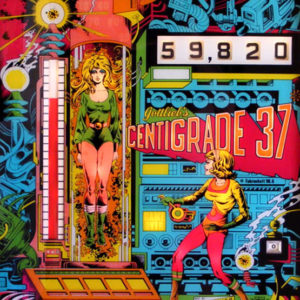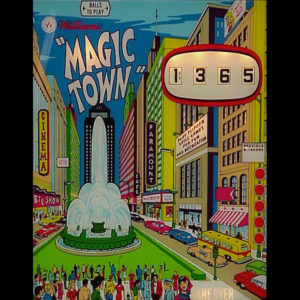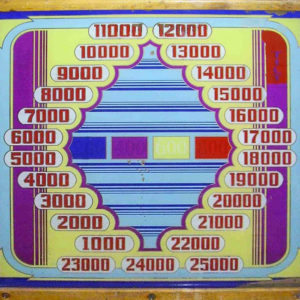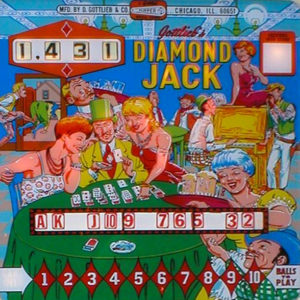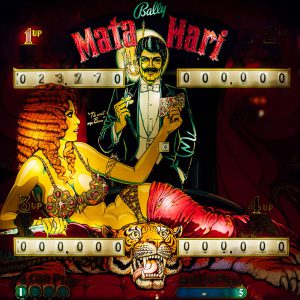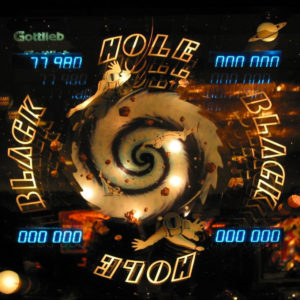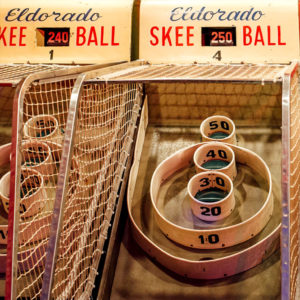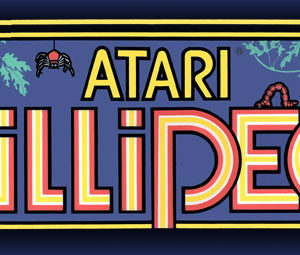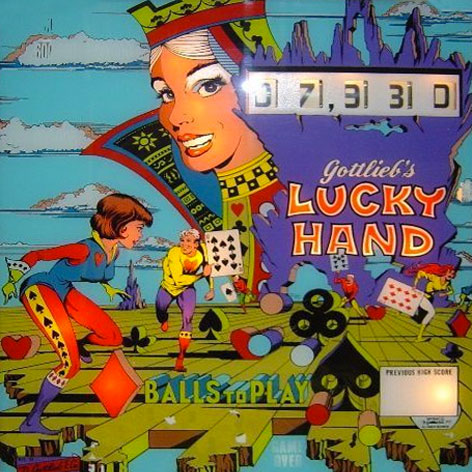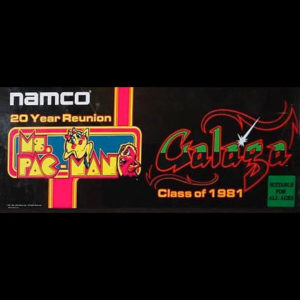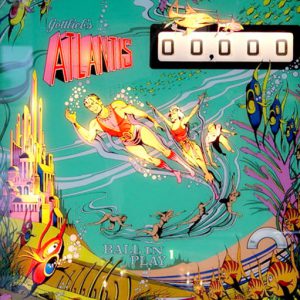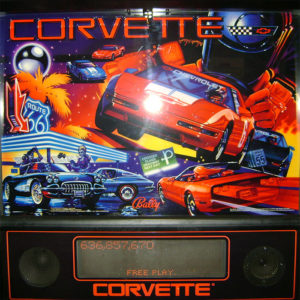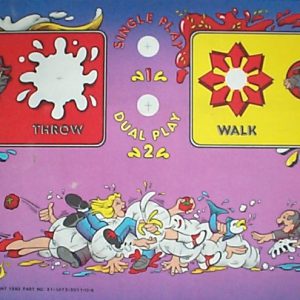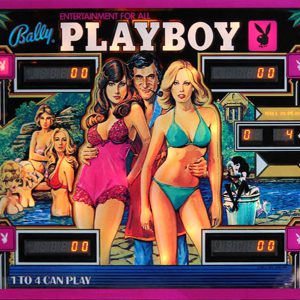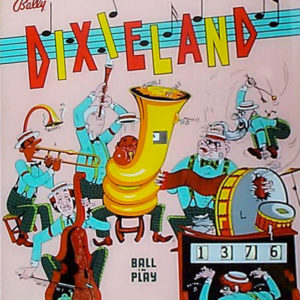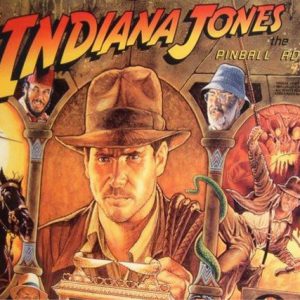-

Arcade (24)
-

Other (1)
-

Pinball (87)
-
This game scores as the #10 most desirable game of the ’70s. It came out in August, designed by Ed Krynski and Allen Edwell with artwork by Gordon Morrison. Backbox animation is included in the game. A giant thermometer advances when drop targets are hit and by rolling over the rollovers. If the thermometer is advanced to the top, the special lights on the eject hole. A, B, C and D rollovers, if hit, advances the thermometer 5 advances. If a player completes all the letters, he gets 5,000 points in the eject hole. A double bonus feature is present also. All in all, a very fast-paced game. Artists, as a general rule, didn’t help design playfields. They were given the game mechanically more or less completed and had to invent the graphics and theme on their own.Donkey Kong Jr. is a 1982 arcade-style platform video game by Nintendo. It first appeared in arcades, and, over the course of the 1980s, was later released for a variety of platforms, most notably the Nintendo Entertainment System. The game’s title is written out as Donkey Kong Junior in the North American arcade version and various ports to non-Nintendo systems. Its eponymous star, Donkey Kong Jr., also called simply Junior[3] or abbreviated as DK Jr.,[4] is trying to rescue his father Donkey Kong, who has been imprisoned. Donkey Kong’s cage is guarded by Mario, in his only appearance as an antagonist in a video game. This game is the sequel to the video game Donkey Kong, which featured Mario as the hero and Junior’s father as the villain. Plot: Mario (known as Jumpman in Donkey Kong) has captured Donkey Kong and placed him in a cage as punishment for kidnapping his girlfriend Pauline.[5] Donkey Kong Jr. must rescue his father from Mario by working his way through a series of stages. Mario attempts to stop DK Jr. by releasing animals and putting obstacles in his way. When DK Jr. succeeds at the final level, Donkey Kong is freed and kicks Mario into the distance, leaving him to an unknown fate. Gameplay Like its predecessor, Donkey Kong, Jr. is an arcade-style platform game. There are a total of four stages, each with a unique theme. DK Jr. can run left and right, jump, and grab vines/chains/ropes to climb higher on the screen. He can slide down faster by holding only one vine, or climb faster by holding two. Enemies include “Snapjaws,” which resemble bear traps with eyes, bird-like creatures called “Nitpickers”, and “Sparks” that roam across the wiring in one of Mario’s hideouts. To pass the first three stages, DK Jr. must reach the key at the top. In the fourth stage, DK Jr. must push six keys into locks near the top of the stage to free Donkey Kong. After a brief cutscene, the player is taken back to the first stage at an increased difficulty. DK Jr. loses a life when he touches any enemy or projectile, falls too great a distance, or falls off the bottom of the screen. Additionally, he loses a life if the timer counts down to zero. The game ends when the player loses all of his or her lives.Pro Pool originated in December with 800 units being fabricated. This add-a-ball machine was designed by Ed Krynski with artwork by Gordon Morison. Two replay versions of the game were also made: a two-player version called Big Shot and a four-player version called Hot Shot. Obviously the theme of this game is the game of pool. The playfield is symmetrical and the way to win extra balls is by completing the left and/or right drop target battery. Doing so will lift the left and/or right wow rollovers for this award. The drop targets reset once the sequences are completed. Of course, an operator-adjusted score is another way to score a couple of balls. Back in the ‘70s, multiple balls or replays could be achieved on the game. Today, one free game on a current solid-state game is the common win. Operators have made it harder to achieve free games today as free games yield no income and only result in down time for the machine to earn coins in the till.Mata Hari was released in April of the year and designed by Jim Patla with artwork accolades going to Dave Christiansen. 16,200 of these machines were produced in the new solid-state format (as seen in the museum) as well as bunch of electromechanical machines (170, to be exact) to keep the non-computer savvy operators happy and buying machines they knew how to fix. This machine before you is one of the finest examples of this ultra-rare mechanical format. Like the solid-state version, the center kickout hole scores 3,000 points and each successful shot in the hole advances the bonus multiplier. The A and B skill shots advance the horizontal sequence of increasing values in the center of the playfield. 50,000 points are awarded when a battery of drop targets is hit. If both batteries are knocked down, the drop targets reset and hitting all again awards the replay. Score is another replay option.This roll-up game is a classic which originated in 1909 in Philadelphia, Pennsylvania. It is one of the first redemption games ever made, with tickets being awarded as higher and higher scores are achieved. Batteries of these machines were a common staple on every boardwalk down the Jersey Shore. Nowadays, the game is still being made and is popular for all ages. The newest twist with the popularity of these machines is the formation of leagues which, like bowling, compete for trophies and bragging rights. Players go by the name of Ski-diddies, and a recent competition was televised on ESPN . These games are relatively easy to cheat on, by dropping balls in the high-scoring holes. That’s why the nets were incorporated into the design of more contemporary machines to limit this activity.Similar to Centipede, the object of the game is to destroy a millipede that advances downward from the top of the screen. The millipede travels horizontally until it either hits an obstacle or reaches the edge of the screen, after which it drops one row and reverses direction. Once it enters the player’s gray maneuvering area, it stays there and extra heads appear at intervals until both they and the millipede are destroyed. Shooting a body segment splits the millipede in two, with the rear portion sprouting its own head. A collision with any enemy costs the player one life. New enemies and gameplay elements are introduced in Millipede: Earwig: same as the scorpion in Centipede, making mushrooms poisonous so that the millipede will charge straight to the bottom of the screen after touching them. Bee: same as the flea in Centipede, dropping mushrooms in a vertical line and requiring two shots to kill. Spider: same behavior as in Centipede, bouncing irregularly across the player area and eating mushrooms. Multiple spiders can appear at the same time on higher levels. Inchworm: when hit, slows all enemies for a short period of time. Beetle: crawls around the player area for a while, then climbs up and leaves the screen, turning any mushrooms it touches into indestructible flowers. When hit, everything on the screen scrolls down one row. Dragonfly: drops mushrooms while zigzagging down, and can be destroyed with a single shot. Mosquito: bounces off the sides of the screen as it descends diagonally. When hit, everything on the screen scrolls up one row. DDT bomb (stationary): can be blown up with one shot, destroying all enemies and mushrooms within the blast radius. Whenever the mushrooms scroll down, a new bomb is added at the top of the screen. Up to four bombs can be in play at one time. The player scores points for shooting the bomb itself, as well as increased values for any enemies destroyed in the blast. All flowers and poisoned/partially destroyed mushrooms revert to normal, whole mushrooms and score points during the process when the player loses a life. At regular intervals during the game, the player will face a swarm of enemies (bees, dragonflies, etc.) instead of the usual millipede. Each enemy destroyed awards increasing points, up to a maximum of 1,000 points per enemy; this attack ends when either the entire swarm has passed or the player loses a life. Also, at intervals new mushrooms will grow on the field while others die off, in a pattern similar to Conway’s Game of Life. Players can also choose at the start of the game whether to play at an advanced level, starting with a score that is a multiple of the number of points needed to earn an extra life (by default, 15,000). The gameplay is generally much more advanced than it would be had the player started with a score of 0 and worked their way up to that point level. The maximum advanced level allowed is a function of the preceding player’s score, and games started at an advanced level where the player did not earn at least one extra life are not eligible for the high scoreboard.This game by Gottlieb is a very challenging design. It was invented by Ed Krynski and artwork was drawn by Gordon Morrison. This game has 10 drop targets lined up the left side of the playfield. If one target is hit, one scores 500 points. If, however, you’re skillful enough to hit a blue and white target at the same time, 5,000 points are awarded. Completing the sequence 1-9 lights the special at the bottom left rollover as well as lights the drop targets to score a special if all the targets are dropped. The player had to be wary when trying to freeze the ball on the right flipper, as one could lose the ball up the right guide rail (which has an opening in it the size of a ball). This playfield design was used a few times by Gottlieb, as it was a successful design (games like Gottlieb 300, for example, a bowling themed game). Scoring games by core were another option.This solid-state game was very popular when it was released and has a lot of smooth shots to complete. It was designed by Jim Patla with artwork by Paul Faris. Production run was 18,250 units. This pre-speaking pinball has Hugh Hefner on its backglass with Bunny Sondra Theodore posing. At the top of the game are four rollover lanes, which advance when hit to a special and advance the bonuses and grotto award. Hitting the five Bunny targets also advance a feature to win extra balls and specials. A unique kickback lane advances with every entrance into it. A five-pack of drop targets also advance certain features on the game. If 20,000 points are made on the bonus system, this point count is carried over to all remaining balls and then some. The nicest shot on the game is going up the right side from the flipper and looping the ball into the grotto. The sound originates from the old TV show “Playboy After Dark.”This massive baseball “pitch and bat” game is considered one of the best baseball games of its era. One or two players could play this behemoth at once, with each player alternating for three innings of play for a nickel or dime. The pitcher may randomly press one of three pitch buttons to pick a weak-to-strong pitch to the batter. The open play field allows one to try and score a home run in one of three bleachers. If you can achieve getting a homer in all three bleachers during your three outs, 30 extra runs are awarded. Then, of course, the ultimate tag of the ball would land the ball in the super home run hole, a rare achievement. This would also award 30 extra runs. Another unique feature of United baseball machines is the scoring of three singles if the ball drops in front of the ramps. These games are also notorious for having a slew of “out” holes. Batter up!12,716 of these Mark Ritchie-designed games were produced in wide-body format. This machine has a lot of the action associated with the first three Indiana Jones adventures produced by Lucas and Spielberg and is rated in the top 10 machines of the ‘90s. Four multiball modes grace this machine as well as a ton of video clips designed by Brian Eddy. Twelve different scenes from the movies are represented. Completing these scenes awards a six-ball multiball sequence. A three-ball multiball sequence may be had by hitting the center drop targets and popping a ball into the drop hole behind them. The path of adventure is lit by hitting the letters in the word “adventure.” Doing so opens the path up the right ramp to the tilt-a-matic playfield in the upper left. The object here is to use the flipper buttons to guide the ball to glory.
-

Arcade (24)
-

Other (1)
-

Pinball (87)
-
This game scores as the #10 most desirable game of the ’70s. It came out in August, designed by Ed Krynski and Allen Edwell with artwork by Gordon Morrison. Backbox animation is included in the game. A giant thermometer advances when drop targets are hit and by rolling over the rollovers. If the thermometer is advanced to the top, the special lights on the eject hole. A, B, C and D rollovers, if hit, advances the thermometer 5 advances. If a player completes all the letters, he gets 5,000 points in the eject hole. A double bonus feature is present also. All in all, a very fast-paced game. Artists, as a general rule, didn’t help design playfields. They were given the game mechanically more or less completed and had to invent the graphics and theme on their own.



